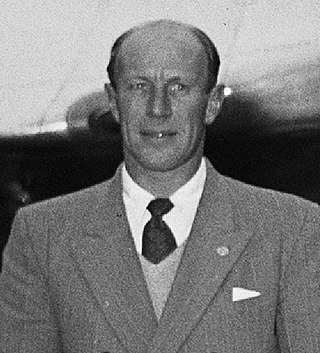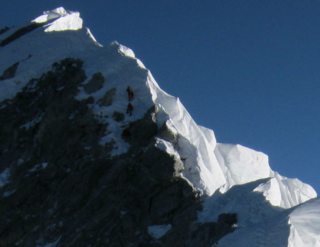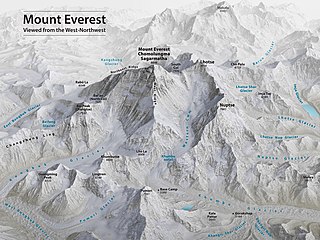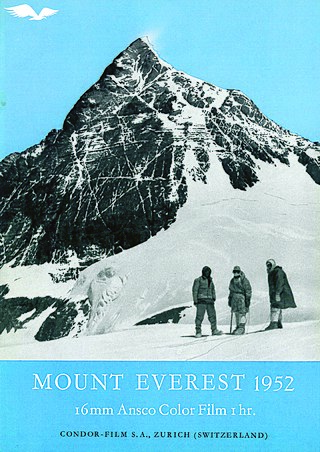Related Research Articles

Mount Everest, known locally as Sagarmatha or Qomolangma, is Earth's highest mountain above sea level, located in the Mahalangur Himal sub-range of the Himalayas. The China–Nepal border runs across its summit point. Its elevation of 8,848.86 m was most recently established in 2020 by the Chinese and Nepali authorities.

Sir Edmund Percival Hillary was a New Zealand mountaineer, explorer, and philanthropist. On 29 May 1953, Hillary and Sherpa mountaineer Tenzing Norgay became the first climbers confirmed to have reached the summit of Mount Everest. They were part of the ninth British expedition to Everest, led by John Hunt. From 1985 to 1988 he served as New Zealand's High Commissioner to India and Bangladesh and concurrently as Ambassador to Nepal.

Tenzing Norgay, born Namgyal Wangdi, and also referred to as Sherpa Tenzing, was a Nepalese-Indian Sherpa mountaineer. On 29 May 1953, he and Edmund Hillary were the first confirmed to have reached the summit of Mount Everest, as part of the 1953 British Mount Everest expedition. Time named Norgay one of the 100 most influential people of the 20th century.

Raymond Lambert was a Swiss mountaineer who together with Sherpa Tenzing Norgay reached an altitude of 8611 metres of Mount Everest, as part of a Swiss Expedition in May 1952. At the time it was the highest point that a climber had ever reached. There was a second Swiss expedition in autumn 1952, but a party including Lambert and Tenzing was forced to turn back at a slightly lower point. The following year Tenzing returned with Edmund Hillary to reach the summit on 29 May 1953.

Jamling Tenzing Norgay is an Indian Sherpa mountaineer from Darjeeling.

The Hillary Step was a 40-foot vertical rock face that sits 8,790 metres (28,839 ft) above sea level. It was located near the summit of Mount Everest. Located on the Southeast ridge, halfway between the "South Summit" and the True Summit, the Hillary Step was the most technically difficult part of the typical Nepal-side Everest climb and the last real challenge before reaching the top of the mountain. The rock face was destroyed by an earthquake that struck the region in 2015.

Mount Everest is the world's highest mountain, with a peak at 8,849 metres (29,031.7 ft) above sea level. It is situated in the Himalayan range of Solukhumbu district, Nepal.

Nawang Gombu was a Sherpa mountaineer who was the first man in the world to have climbed Mount Everest twice.
Tashi Wangchuk Tenzing is an Indian-born Australian Sherpa mountaineer. His maternal grandfather, Tenzing Norgay, made the first ascent of Mount Everest on 29 May 1953.

Peter Edmund Hillary is a New Zealand mountaineer and philanthropist. He is the son of Sir Edmund Hillary, who, along with mountaineer Tenzing Norgay, completed the first successful ascent of Mount Everest. When Peter Hillary summited Everest in 1990, he and his father were the first father/son duo to achieve the feat. Hillary has achieved two summits of Everest, an 84-day trek across Antarctica to the South Pole, and an expedition guiding astronaut Neil Armstrong to land a small aircraft at the North Pole. He has climbed many of the world's major peaks, and on 19 June 2008, completed the Seven Summits, reaching the top of the highest mountains on all seven continents, when he summited Denali in Alaska.

The 1996 Mount Everest disaster occurred on 10–11 May 1996 when eight climbers caught in a blizzard died on Mount Everest while attempting to descend from the summit. Over the entire season, 12 people died trying to reach the summit, making it the deadliest season on Mount Everest at the time and the third deadliest to date after the 23 fatalities resulting from avalanches caused by the April 2015 Nepal earthquake and the 16 fatalities of the 2014 Mount Everest avalanche. The 1996 disaster received widespread publicity and raised questions about the commercialization of Everest.
Lopsang Jangbu Sherpa was a Nepalese Sherpa mountaineering guide, climber and porter, best known for his work as the climbing Sirdar for Scott Fischer's Mountain Madness expedition to Everest in Spring 1996, when a freak storm led to the deaths of eight climbers from several expeditions, considered one of the worst disasters in the history of Everest mountaineering. Notwithstanding controversy over his actions during that expedition, Lopsang was well-regarded in the mountaineering community, having summited Everest four times. Lopsang was killed in an avalanche in September 1996, while again on an expedition to climb Everest for what would have been a fifth ascent.

Wallace George Lowe, known as George Lowe, was a New Zealand-born mountaineer, explorer, film director and educator. He was the last surviving member of the 1953 British Mount Everest Expedition, during which his friend Edmund Hillary and Sherpa Tenzing Norgay became the first known people to summit the world's highest peak.

The 1952 Swiss Mount Everest expedition was an attempt to summit Mount Everest. Led by, Edouard Wyss-Dunant, the expedition, which included Tenzing Norgay, reached a height of 8,595 metres (28,199 ft) on the southeast ridge, setting a new climbing altitude record and opening up a new route to Mount Everest and paving the way for further successes by other expeditions. Norgay successfully summited the mountain the following year with Sir Edmund Hillary, the first successful expedition.

The 1953 British Mount Everest expedition was the ninth mountaineering expedition to attempt the first ascent of Mount Everest, and the first confirmed to have succeeded when Tenzing Norgay and Edmund Hillary reached the summit on 29 May 1953. Led by Colonel John Hunt, it was organised and financed by the Joint Himalayan Committee. News of the expedition's success reached London in time to be released on the morning of Queen Elizabeth II's coronation, on 2 June that year.
Mamta Sodha is an Indian sportsperson, known for her successful 2010 attempt to scale Mount Everest. She was honoured by the Government of India, in 2014, by bestowing on her the Padma Shri, the fourth highest civilian award, for her services to the field of mountaineering sport.

The South Summit is a subsidiary peak of Mount Everest in the Himalayas between the South Col and the main summit above sea level. Although the South Summit's elevation of 8,749 metres (28,704 ft) is higher than the second-highest mountain on Earth, it is not considered a separate mountain as its topographic prominence is only 11 meters.

The 1965 Indian Everest Expedition reached the summit of Mount Everest on 20 May 1965. It was the first successful scaling of the mountain by an Indian climbing expedition.
References
- 1 2 Hillary Reminisces on Everest Feat : Nepal: It was 17 below and the wind blew slivers of ice as the New Zealander and his Sherpa guide scaled the last 1,100 feet to the top of the world on 29 May 1953. - 30 May 1993 - ARTHUR MAX
- ↑ People Magazine - Tenzing Norgay, the Sherpa Peasant Who Conquered Everest, Dies Quietly at Home - By Joshua Hammer - 26 May 1986
- ↑ Asia, Nepal, Mount Everest, Pre-Monsoon Summary
- ↑ CLIMBING EVEREST: WHO MAKES IT TO THE TOP? By John Florio and Ouisie Shapiro
- ↑ Narula, Svati Kirsten (21 April 2014). "Charting Deaths on Mount Everest". The Atlantic. Retrieved 12 October 2022.